


Sheep shearing is a crucial skill for any sheep farmer. This blog post covers the essential techniques and tips for effective and humane sheep shearing.
Introduction to Sheep Shearing
Shearing is the process of removing a sheep’s fleece. It is typically done once a year and is essential for the sheep’s health and comfort. Proper shearing techniques ensure the wool is of high quality and the sheep remain unharmed.
Preparing for Shearing
Preparation is key to a successful shearing session. Gather all necessary equipment, including shears, combs, and cutters. Ensure the shearing area is clean, well-lit, and free of distractions.
Read also: Sustainable Sheep Farming Practices: A Guide to Eco-Friendly Sheep Farming
Shearing Equipment
Invest in high-quality shearing equipment. Electric shears are commonly used for their efficiency. Keep blades sharp and well-maintained. Have a first aid kit on hand in case of minor cuts or injuries.
Handling Sheep
Handling sheep gently and securely is important to minimize stress and injury. Use a proper restraining technique, such as sitting the sheep on its rump. Calm and controlled movements help keep the sheep relaxed during shearing.
The Shearing Process
Follow these steps for efficient shearing:
Position the Sheep: Sit the sheep on its rump with its back against your legs. This position keeps the sheep calm and still.
Start with the Belly: Begin shearing at the belly, as the wool here is usually less valuable. Work from the belly to the neck and shoulders.
Move to the Sides: Shear the sides, working from the top down. Use long, smooth strokes to remove the fleece in one piece.
Finish with the Back: Shear the back and legs last. Ensure all wool is removed, and check for any missed spots.
Inspect and Clean: After shearing, inspect the sheep for any cuts or injuries. Apply antiseptic if necessary and clean the shearing area.
Wool Handling
Proper handling of wool ensures its quality and market value. Spread the fleece on a clean surface and remove any dirt, debris, or second cuts. Roll the fleece neatly for storage or sale.
Post-Shearing Care
After shearing, keep the sheep in a sheltered area until they adjust to the temperature change. Monitor them for signs of stress or injury. Provide fresh water and feed to help them recover.
Common Mistakes to Avoid
Rough Handling: Causes stress and injury. Handle sheep gently and calmly.
Dull Blades: Make shearing difficult and increase the risk of cuts. Keep blades sharp.
Improper Technique: Results in poor wool quality and potential harm to the sheep. Learn and practice proper shearing techniques.
Conclusion
Sheep shearing is a vital skill for maintaining sheep health and wool quality. By preparing adequately, using proper equipment, and handling sheep gently, you can ensure a successful and humane shearing process. Regular practice and attention to detail will improve your shearing skills over time, benefiting both your sheep and your farming operation.



